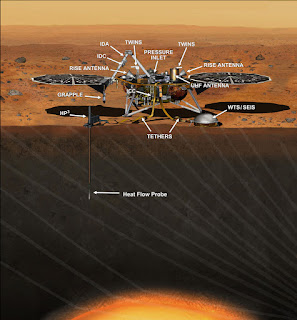NASA's InSight Mars Lander: Overview and Objectives
Image source: NASA
Along with InSight, the 2 CubeSat called 'MarCO A and B' were also launched which are currently trailing behind the Mars' InSight lander. It will work as communication and relay satellite and will help us to communicate with InSight on its way. They'll not enter the orbit of Mars.
InSight stands for Interior Exploration using Seismic Investigations, Geodesy and Heat Transport. And as the name says, it will focus more on the interior of the Mars. Now lets look at some of its jobs which has to be done on Mars.
OBJECTIVES
1) TO MEASURE MARSQUAKES
The Seismic Experience for Interior Structure (SEIS) will detect and take a precise measurements of Marsquakes and other internal activities. The Seismometer will also detect atmospheric waves and gravimetric signals (tidal forces) from Phobos (Mars' moon), up to high frequency seismic waves of 50 Hz.
2) TO MEASURE HEAT COMING FROM MARS' CORE
The Heat flow and Physical Properties Package (HP3) instrument, is a self-penetrating heat flow probe. It will dig up to 5 m below the surface to measure how much heat is coming from Mars' core.
3) TO MEASURE PLANETARY ROTATION
The Rotation and Interior Structure Experiment (RISE) will be used to provide precise measurement of planetary rotation to understand the interior of Mars. Once the spin axis direction, precession, and nutation amplitudes are better understood, than it would help us to calculate the size and density of the Martian core and mantle.
4) TO MONITOR WEATHER
Temperature and Wind for InSight (TWINS) will help us to monitor weather of Mars' atmosphere at the landing site.
This are the few main objectives of InSight lander which will help to increase our knowledge about the Red Planet. This project is one of the best and my personal favorite. Let me know your thoughts on it in comments below.





Comments
Post a Comment